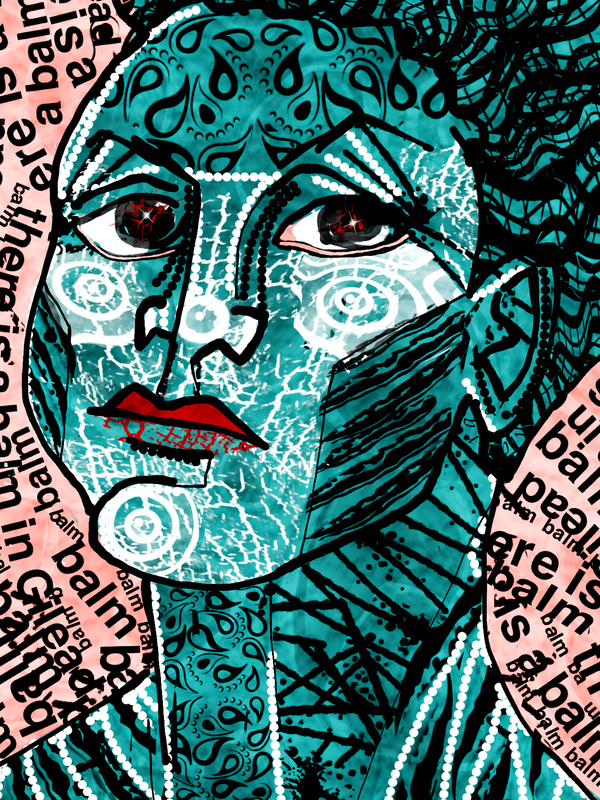| It's always a bit problematic when white folk (like me) try to deal with the subject of slavery in America -- the issue being how to handle it in a way sensitive to African-American sensibilities. However, yesterday was Juneteenth here in Texas -- a commemoration of the day the news of the Emancipation Proclamation came to the slaves in Texas. It's a big celebration here in the Black community. So, I'm taking the opportunity to commemorate it in my own way, with this sketch, titled "There is a Balm in Gilead." The title references the traditional spiritual by the same name. Which itself references the book of Jeremiah, Chapter 8, v. 22: "Is there no balm in Gilead? Is there no physician there? Why then is there no healing for the wounds of my people?" Here I've tried a different style than my usual, drawing a stylized face and filling it with patterns, thus referencing the tribal scarifications that many Africans must have had when they were enslaved. These scarifications would have been a positive part of their culture. But in America, slaves bore other scars, both from being branded like cattle and from being beaten and whipped. |
| Texas likes to pretend that it's not really part of the South, but it was indeed a part of the Confederacy. The State of Texas still, believe it or not, gives "Confederate Heroes Day" as well as Martin Luther King's Birthday, as a holiday for state government workers. Many Southern whites have bought into the idea that the Civil War was not about slavery, but instead about state's rights. One glaring fact: the "state right" that the southern states most wanted to keep was the "right" to "own" slaves. Don't believe me? Check out the Declarations of Secession by those states. Read the texts. Slavery was indeed the primary issue. The economy of the South centered upon the cotton fields, worked by slaves. Cotton was King. Slavery was thus considered essential to the economic stability of the Southern states. The growth of the abolitionist movement in the North fueled the controversy over slavery in US Territories. At a certain point, the power structure of the South began to see the writing on the wall. Secession became inevitable. Some argue that since most confederate soldiers didn't own slaves, the war was not about slavery. However, when we ask the question, "How did those soldiers feel about the prospect of all the slaves becoming free? The idea of all blacks having the same civil rights as white folks?" We see the answer in the Jim Crow laws of the post-War South. (at right, see an historical photo of a former slave, with the scarring left by bullwhips) |
| During the Civil Rights Movement, television news programs showed the brutality of white southerners toward the African-American population, shocking most white northerners, altho the black population of the northern states most likely felt no sense of surprise at all. Today, Twitter, YouTube, Facebook and other social media platforms would come into play. Here is a quote from JFK: "We preach freedom around the world, and we mean it, and we cherish our freedom here at home; but are we to say to the world, and, much more importantly, for each other, that this is a land of the free except for the Negroes; that we have no second-class citizens except Negroes; that we have no class or caste system, no ghettos, no master race, except with respect to Negroes?" |
| Alas, I really do believe that at least some of my white friends (those of my Baby Boomer generation) learned everything they know about slavery from "Gone With The Wind." Sigh. And, one funny thing. Once in awhile, I'll see a car with both a "God Bless America" bumper sticker and a Confederate flag decal in the rear window. I really feel like shouting: "Make up your mind!" |




 RSS Feed
RSS Feed